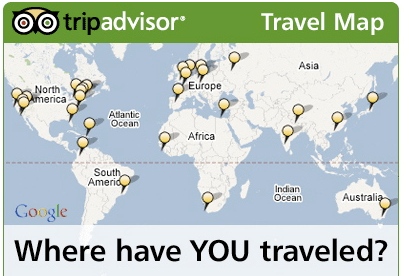
March 10, 2000. This may not jump out at you as a noteworthy date in history, but that was the day the Internet’s so-called ‘dotcom bubble’ peaked, leading to the death of the digital dream for many young startups in Silicon Valley and beyond.
However, whilst the vast majority of the fledgling tech companies crashed and burned, there were some notable success stories to emerge from that whole period – Google, Amazon and eBay to name but a few. But there is another name that probably won’t immediately spring to mind.
Founded a whole calendar month before the original dotcom bubble officially burst, TripAdvisor didn’t choose the best time to launch an online travel website, on paper at least. But it emerged unscathed and is flourishing today despite the wave of new young startups trying to muscle their way in on the action.
In 2011, TripAdvisor raked in $637.06m in revenues, and with 50m unique monthly visitors, 20m members and more than 60m reviews and ‘opinions’ hosted on its site, it’s clearly not being usurped by some young upstart any time soon.
Of course, TripAdvisor has also been drawn into a number of controversies of late, relating to the influence it holds over paying customers looking for somewhere to stay. According to some stories, it’s easy for both customers and hoteliers to leverage this ‘influence’ to get one up on the system.
With that in mind, The Next Web caught up with Adam Medros, VP of global product at TripAdivsor, to discuss Facebook, Twitter, mobile…and try and get to the bottom of some of these criticisms.
TripAdvisor and Facebook, up a tree…

TripAdvisor has been enjoying a rather cosy relationship with Facebook for the past couple of years. You may remember it launched Instant Personalization in partnership with the social networking behemoth back in December 2010. It arrived in the US first, followed by the UK several months later.
If you’re not aware of this feature, here’s how it works. If you visit TripAdvisor’s website while logged into Facebook on your computer, the site will act like your personalized travel planner, complete with friends’ reviews, a map showing places friends have visited, and a list of their most popular destinations. It sounds great, but it hasn’t been without its critics.
“There are eight partners worldwide that have access to Instant Personalization, and we’re the only travel site,” says Adam. The others, if you’re interested, are Bing, Pandora, Yelp, Clicker, Rotten Tomatoes, Scribd and Docs.com.
But the issue, for many, is that it’s an opt-out initiative rather than opt-in, meaning that if you’ve never bothered to disable the feature in your Facebook privacy settings, as soon as you hit the website in question, it automatically connects with your Facebook account. But according to Adam, the opt-out rate is tiny. “It’s fractions of a percentage point,” says Adam. “Most people see utility in it,” he continues.
Indeed, since launch, 89m people have been ‘instantly personalized’ globally. It’s perhaps safe to assume that this will be almost everyone who has a Facebook account they keep logged-in whilst browsing other sites…such as TripAdvisor.
However, the TripAdvisor/Facebook partnership predates Instant Personalization. “We’ve been working with  Facebook for more than four years now,” says Adam. “You can look at it as a couple of stages. One was we started building apps on their platform, such as the Cities I Visited app. We then started to integrate Facebook Connect, and then Instant Personalization.”
Facebook for more than four years now,” says Adam. “You can look at it as a couple of stages. One was we started building apps on their platform, such as the Cities I Visited app. We then started to integrate Facebook Connect, and then Instant Personalization.”
Then in January this year, TripAdvisor launched its part of what Facebook announced at F8, which was open graph and custom actions. So now when you use Cities I visited on Facebook, when you pin a city or rate something inside that app, it will publish it to your timeline, and you can share it in your News Feeds, depending on the permissions you give it.
“We think that’s a really powerful idea, that people inherently do want to share their experiences and their content with their friends,” says Adam. “If they give us their permission, we’ll increasingly ask for that permission, to be able to make it easier for your friends to discover the things that you like. And to get ideas and recommendations for the trips that they’re planning.”
Beyond Facebook

Whilst Facebook is clearly a major partner for TripAdvisor, are Twitter or other social networks on its radar for deeper integration? “We’ve certainly looked at that,” says Adam, “And all the other social networks. We’d consider doing it, but the main thing we want to figure out is what are we getting from it? And how do we make it a better experience for our users? We’ve done a little testing, and users are a little more reticent about pressing a button and sharing it out to their Twitter network and followers.
“With Instant Personalization, what we love about the programme is the ability to…if you were going to, say, Boston and a bunch of your friends had been to Boston and written reviews about Boston restaurants or hotels, you would see those hotels and reviews first in the list of hotels and restaurants,” he continues. “The idea is that, by virtue of the friend graph and social graph, we get some information that helps us personalize your experience that’s good. Twitter is more about communication than that social graph.”
The same, of course, applies to the likes of Google+ which is still finding its feet as a social network. “When it’s big enough, and makes a dent, then yeah, but right now, Facebook is really the only platform that has meaningful scale and provides a graph that could be of real use,” adds Adam.
Red flags and false advertising
Whilst we’d love to have focused on the positive things emanating from TripAdvisor Towers, there’s no getting away from all that negative stuf that have hit the headlines over the past year. You know, the fake reviews and false advertising stuff.
Inside jobs
Last September, we ran a report on an English country hotel that claimed it was facing ruin after TripAdvisor ‘red-flagged’ it over supposed fake (positive) reviews left on the site.
The Riverside Hotel and Restaurant, in Worcestershire, England, complained that since TripAdvisor had placed a warning message beside its listing, bookings had dried up. The hotel-owner said at the time:
“When it went up, the phone stopped ringing. I guarantee 100% I’ve not written anything about my hotel on there.”
The problem was this. TripAdvisor scans reviews to check if it matches a hotel’s IP addresses, to try to curb ‘in-house’ reviews. But the hotel owner, Deborah Sinclair, claimed that the review was written by a customer using the hotel’s WiFi. Quite the dilemma, it would seem, but Adam is adamant that it doesn’t dish out red flags like confetti, and there was much more to this case.
“We encourage hotel visitors not to write reviews from the hotel lobby,” says Adam. “But that’s almost never the only signal that indicates some kind of fraud. So it is a signal, but it’s a pretty simplistic one and we have multiple signals that feed in to it.”
So would they red-flag a hotel purely on a review being written from the hotel lobby? “A singular review from a hotel’s IP address isn’t a strong enough signal on its own,” says Adam. In specific reference to the Riverside Hotel, which was ‘red-flagged’ for writing its own reviews, he continued, “There were multiple, pretty strong signals to us that led to that hotel being red-flagged. It wasn’t a singular review from a long-standing guest, as the hotelier claimed, written in the hotel lobby. It was multiple instances of employees and people affiliated with the hotel writing reviews on behalf of the hotel.”
So, how do they know they’re employees? Skirting ’round the specifics, Adam simply said that they have ‘a number of ways’ to figure this out. “But suffice to say, we shared it with the hotel owner how we identified some of those people, and how they related to the hotelier,” he said. “In our opinion, there wasn’t a lot of doubt in the matter. I don’t think the hotelier agrees, but we were pretty confident about the outcome of that.”
Indeed, the integrity of the content for all intents and purposes is TripAdvisor’s product. Without that, the whole business goes up in smoke, so it is in their interest to ensure that reviews aren’t being rigged, though it’s difficult not to think that sometimes it just may get its conclusions wrong, which could have disastrous effects for those accused. Hoteliers may not even know that they have staff trying to boost the hotel’s fortunes, with the best possible intentions.
“We invest a lot in making sure we’re on top of this from a technology standpoint, and we’re constantly monitoring it,” continues Adam. “We don’t give out red badges lightly, there are a number of instances where we warn them or send them communications where we think something suspicious is happening. When you get to the red flag stage, it has been when you’ve been warned there has been multiple infractions, and there has been repeated abuse of the system.”
The threat of negative reviews…
Some hotel-owners have also complained that customers have threatened to leave negative reviews on TripAdvisor if they didn’t receive discounts or other forms of preferential treatment. Or conversely, it could be the case that hoteliers offer incentives to guests to leave a positive review.
“Those are both tricky cases,” says Adam. “In terms of review incentivization, we’ve always said to hoteliers, we absolutely encourage you to ask visitors to write reviews, but we won’t allow them to offer something in return. Naturally, this would tilt it towards a good review, and it cherry-picks and biases the information. Incentive cases are a lot easier, we can find out about them, because users tell us, saying ‘hey, I was given an incentive to leave a review’. Or competitors tell us, and we go and investigate, and that usually goes through our process of giving a hotel a warning.”
“The threats from users that if, say, they don’t get an upgrade or if they don’t get better service, they’ll write a negative review, now…that’s tricky,” adds Adam. “We absolutely recognize that and it’s something we spend a lot of time on internally, reviewing and thinking through some of the processes. It’s still a work-in-progress. We generally say to hoteliers, ‘tell us, send an email, give us a call on our hotline, so we can look for that review, and we can decide to take action when that review comes in. Often, threats are just that though…and they don’t materialize.”
However you view this, this is consistent for all online review sites. Even factoring in difficult customers, the idea is, I guess, that if the hotel does offer genuinely good service, the positive noise will almost always drown out the negative noise.
False advertising…
Back in September, it was reported that the UK’s Advertising Standards Authority (ASA) was investigating TripAdvisor, following a complaint it received from a company called KwikChex. It argued that claims on the website such as ‘reviews you can trust’, ‘read reviews from real travellers’, ‘TripAdvisor offers trusted advice from real travellers’, among others, are misleading and can’t be backed up.
The ASA finally ruled last month that certain marketing phrases were to be banned from use in the UK. “We don’t agree, we think that their expectation is out of line with what users’ expectation are,” says Adam. “Users don’t expect any such site, whether it’s Amazon, or us – to guarantee that every word is 100% true and has been through the ringer. We think that the ASA is a little bit blind as to where the industry and where the market is. And more importantly the general media panel, a subset of the ASA, ruled in the other direction in favor for us.”
So, what was the upshot of all this? Well, very little, it would seem. “We changed like three sentences on the UK website, and it’s had no effect on the business. And from the user perspective, it doesn’t change a single thing.”
Mobile

Being a website about travel, TripAdvisor and mobile pretty much go hand-in-hand. They’re a good fit. TripAdvisor reached 13 million total downloads of mobile apps, and 16 million unique visitors per month via mobile devices, as of December 31, 2011.
During Mobile World Congress in Barcelona, TripAdvisor announced that the TripAdvisor app was downloaded an average of 25 times per minute in January, and had surpassed 15 million total downloads across all platforms and devices in 20 languages.
TripAdvisor also launched 20 free city guides for Android and iOS over October and November last year, offering access to traveler reviews on hotels,restaurants and attractions, as well as suggested itineraries and offline-accessible interactive walking tours.
In addition to all this, TripAdvisor launched its Android tablet app earlier this year. “It’s a whole, brand new rebuild of our tablet app, with HTML 5 underneath, but it’s a native Android app,” says Adam. “We really focused on what the tablet experience should be versus the mobile experience.”
So…HTML 5 underneath a native app? This seemed like a good time to ask Adam what he thinks the future looks like for apps, native or HTML 5?
“We’ll do whatever makes the most sense for consumers,” he says. “That’s a sort of a trite answer, but it’s true. At the feature level, there are definitely things that you need and want from an app. Photos is the most notable one – Web apps don’t have access to the photos store. So we can’t ask a user to load a photo they’ve just taken on their mobile device.”
Future gazing

With mobile beginning to underpin much of TripAdvisor’s development, how can it take on more context-aware smart recommendation technologies that are starting to emerge?
“That’s one of the great things about mobile,” says Adam. “TripAdvisor has such great content. With GPS, when you are right there, at a location, and you want to know the best restaurant there and then, rather than in advance, so we built a feature called ‘Near me Now’.”
The ‘Near me Now’ feature is built into its mobile apps, and taps TripAdvisor ratings to pick the best of what’s nearby, as they’re, say, driving along a motorway.
“I think we’ll continue to invest in technologies that are location-aware,” continues Adam. “Social, too, is the next thing we want to continue to build in to mobile, we do a lot of it on desktop but we haven’t really brought the social layer to mobile yet and we think that could be really relevant. Imagine if you use the ‘Near me Now’ function, and it suggests restaurant nearby, but just a little further in the distance was a restaurant your friend liked. You might value that recommendation and walk a little bit further to go to it.”
Looking further ahead, Adam tells us that TripAdvisor is building out a more robust API and make it available to more developers, in addition to the partner developers it already has today. Its current API is for licensed partners only and is not publicly accessible. “We’re going to update that API to be a little more modern and standards-compliant, and hopefully make that available to more people and see what they build,” he says.
So what could this herald? Well, a recent TripAdvisor hack day produced something pretty cool, according to Adam. An iOS app that uses the accelerometer and the compass on the iPhone. “The idea was if you’re driving on the highway, it streams a list of restaurants in front of you,” he says. “With voice commands you give it instructions to filter by certain types of restaurants. This is an experience a lot of people will be familiar with, driving along, finding somewhere to eat. And then directions on how to get there.”
Whilst this example wasn’t anywhere near “ready for prime time”, as Adam put it, it’s an example of a feature that could be built inside of a TripAdvisor app. Or maybe even as a standalone TripAdvisor-branded app? Time will tell.
Get the TNW newsletter
Get the most important tech news in your inbox each week.





